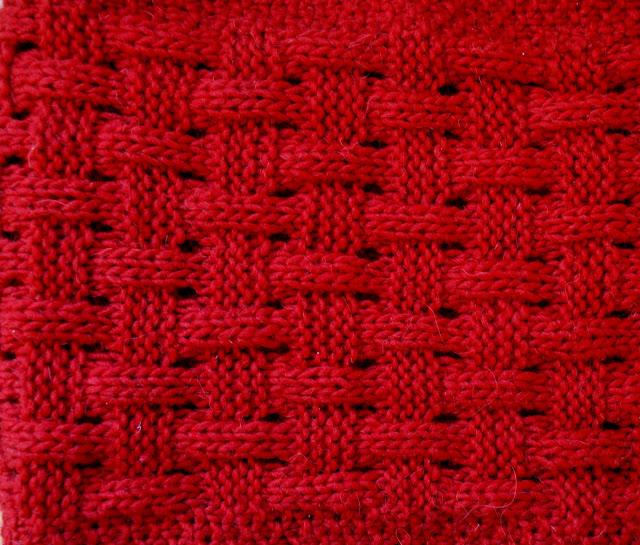
It’s time to follow up with the infinity or loop scraf topic. A wrapped around your neck knitted infinity scarf will keep you warm during cold winter times. As an alternative to sewing a loop scarf from a warm wool fabric you can knit yourself one.

For this knitted scarf a basketweave knitting pattern was used. Basketweave pattern is an easy stitch pattern that combines knits and purls into a fabric that looks woven and really pretty.
Materials
- 6 mm Knitting Needles
- 2 Skeins of red wool yarn (5 0z. each)
Size
The infinity scarf is 40 in/ 100 cm long and 10 in/25cm wide
Basketweave Pattern
Alternating knit and purl stitches created this richly textured pattern. (multiple of 8 sts plus 10)
Row 1,3: K1, P1, K1, P1, K1 *K2, P5 * end K1, P1, K1, P1, K1.
Row 2,4: P1, K1,P1, K1, P1 *P2, K5 *, end P1, K1,P1, K1, P1.
Row 5: K1, P1, K1, P1, K1 *K * K1, P1, K1, P1, K1
Row 6: P1, K1,P1, K1, P1 *P* P1, K1,P1, K1, P1
Row 7,9: P1, K1,P1, K1, P1 *P2, K5 *, end P1, K1,P1, K1, P1.
Row 8, 10: K1, P1, K1, P1, K1 *K2, P5 * end K1, P1, K1, P1, K1.
Row 11: Rep. Row 5
Row 12: Rep. Row 6
Repeat rows 1-12
Abbreviations:
K = KnitP = PurlRep. = Repeat


Moreover, one should keep in mind that there’s more than one way to wear an infinity loop scarf.
- Single loop
- Capelet
- Double loop
- Double loop with hood
- Shawl


Check out the ‘How To Wear an Infinity Scarf‘ blog post for more photos.


COMMENTS ( 2 )
posted on 21 April at 09:32
This knitted scarf basketweave pattern is good. I like this one, and it fits with its color. The color is very lively. Thanks for sharing as well as the tutorial pattern.
posted on 21 April at 01:02
Love the red basket weave infinity scarf but need more instructions. how many to cast on and general instructions. the seed stitch etc. thanks
posted on 03 January at 00:26
Working on figuring out if the graph is correct and if not correcting it. Then and if I do I'll post a corrected version. Is that legal? I really don't know. I like this design to much to give up on it.
posted on 02 January at 19:12
Is there a corrected pattern for the scarf in the photo showing the y/o's etc?
posted on 05 October at 04:41
It seems to me, just guessing, that Lucy is leaving it up to the knitter to figure out how many stitches to cast on, based on the finished dimensions she provided for the scarf: "10" wide" ...so what ever number of stitches it would take to achieve that width, based on the size needle you use, and how many stitches are required to achieve the pattern.
Okay, I "think" I have it figured out, haven't made it yet, but will be trying this:(I'm using a size 7 needle)
I get approx 66 stitches needed to cast on to make 10" wide.
The edges of the scarf take 5 stitches (K1, P1, K1, P1, K1) for the right and 5 stitches (K1, P1, K1, P1, K1) for the left side for a total of 10 stitches, which is almost 2" total just for the edges. The pattern takes 7 stitches (K2, P5 and then P2, K5 in next row, alternating this) So the number of stitches for the pattern has to be divisible by 7. I figured 56 stitches to make 8 patterns across to come up with the approx 10" wide scarf. If you wanted the scarf to be a bit wider, increase the number of stitches by 7 for each pattern, so 63 stitches to make 9 patterns across, plus 10 stitches for the right and left edges for a total of 73 stitches to cast on. Make sense? Also, I would cast off continuing in the pattern so when you sew the top and bottom together the pattern would connect and appear "infinity"
posted on 31 March at 14:32
This scarf is beautiful. I tried it, but it did not turn out at all like the picture. You're right Ieda, it is a multiple of 7, not 8. At any rate, the diagram shows yarn over and knit 2 together, but those are not even mentioned in the written directions. I don't know what happened, but I am looking for another basketweave pattern!
posted on 18 October at 13:11
Hi, the repeat is k2 p5, and the pattern says 8+10, where's the mistake? Should it be k3 p5; k2 k6?
Alternating knit and purl stitches created this richly textured pattern. (multiple of 8 sts plus 10)
Row 1,3: K1, P1, K1, P1, K1 *K2, P5 * end K1, P1, K1, P1, K1.